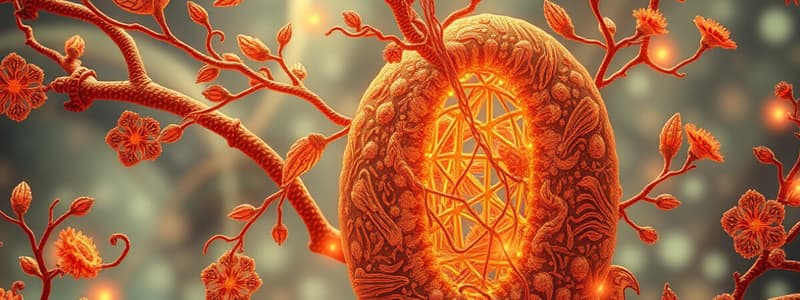Podcast
Questions and Answers
What is the difference between aerobic and anaerobic respiration?
What is the difference between aerobic and anaerobic respiration?
Aerobic respiration requires oxygen to produce energy. Anaerobic respiration doesn't require oxygen to produce energy.
What does A.T.P. stand for?
What does A.T.P. stand for?
Adenosine Tri-Phosphate
What are the 3 primary stages of Cellular Respiration (in order from beginning to end)?
What are the 3 primary stages of Cellular Respiration (in order from beginning to end)?
Glycolysis, The Krebs Cycle, The Electron Transport Chain
What is another name for the Krebs Cycle?
What is another name for the Krebs Cycle?
Which stage(s) of Cellular Respiration can be Aerobic or Anaerobic?
Which stage(s) of Cellular Respiration can be Aerobic or Anaerobic?
What is the formula for cellular respiration? Name the reactants and products.
What is the formula for cellular respiration? Name the reactants and products.
Where does the electron transport chain take place?
Where does the electron transport chain take place?
How much energy in a glucose molecule is transferred to ATP during cellular respiration?
How much energy in a glucose molecule is transferred to ATP during cellular respiration?
What happens in alcoholic fermentation?
What happens in alcoholic fermentation?
What kind of fermentation by yeast is used in baking and brewing?
What kind of fermentation by yeast is used in baking and brewing?
What is Lactic Acid Fermentation?
What is Lactic Acid Fermentation?
How much ATP does Cellular Respiration produce compared to what fermentation produces?
How much ATP does Cellular Respiration produce compared to what fermentation produces?
How much ATP is produced in the Electron Transport Chain?
How much ATP is produced in the Electron Transport Chain?
In what industry is alcoholic fermentation used?
In what industry is alcoholic fermentation used?
What does ATP do for you?
What does ATP do for you?
In which organic life-forms does Cellular Respiration take place?
In which organic life-forms does Cellular Respiration take place?
Where does glycolysis take place?
Where does glycolysis take place?
What is the equation for photosynthesis (Think about the relationship between cellular respiration and photosynthesis)?
What is the equation for photosynthesis (Think about the relationship between cellular respiration and photosynthesis)?
What energy molecules are produced in cellular respiration?
What energy molecules are produced in cellular respiration?
What is Cellular Respiration?
What is Cellular Respiration?
Also called the citric acid cycle, _____ is the middle stage.
Also called the citric acid cycle, _____ is the middle stage.
The net gain from the _____ is 2 ATP.
The net gain from the _____ is 2 ATP.
The _____ sends more electrons to NADH and then FADH2, and the pyruvic acid is converted to acetyl-CoA.
The _____ sends more electrons to NADH and then FADH2, and the pyruvic acid is converted to acetyl-CoA.
What is the difference between Photosynthesis and Cellular Respiration (based on their 2 equations)?
What is the difference between Photosynthesis and Cellular Respiration (based on their 2 equations)?
If you are running away from a lion in the jungle how long does it take to 'spend' each 'form' of energy?
If you are running away from a lion in the jungle how long does it take to 'spend' each 'form' of energy?
During intense exercise, which process will the muscles mainly use?
During intense exercise, which process will the muscles mainly use?
In the yeast respiration lab, which set-up produced more Carbon Dioxide? Why?
In the yeast respiration lab, which set-up produced more Carbon Dioxide? Why?
What is the best form of exercise that will help you lose weight? Why?
What is the best form of exercise that will help you lose weight? Why?
Flashcards are hidden until you start studying
Study Notes
Cellular Respiration Overview
- Aerobic respiration requires oxygen; anaerobic respiration does not.
- Cellular respiration occurs in three primary stages: glycolysis, Krebs Cycle, and the electron transport chain.
- ATP stands for Adenosine Tri-Phosphate, the energy currency of cells.
Processes and Reactions
- The Krebs Cycle is also known as the Citric Acid Cycle and can occur under both aerobic and anaerobic conditions.
- The general formula for cellular respiration:
- 6O2 + C6H12O6 → 6H2O + 6CO2 + 36-38 ATP
- Glycolysis occurs in the cytoplasm, while the electron transport chain takes place in the cristae of mitochondria.
Fermentation
- Alcoholic fermentation converts pyruvate to ethanol in a two-step process, releasing CO2.
- Lactic Acid Fermentation reduces pyruvate to NADH, forming lactate without CO2 release.
- Alcoholic fermentation is utilized in baking and brewing industries.
Energy Production
- Cellular respiration produces significantly more ATP (36-38 ATP) compared to fermentation (2 ATP).
- The electron transport chain yields 32-34 ATP.
- Cellular respiration is critical for energy supply, especially in animals.
Comparative Biology
- Photosynthesis and cellular respiration are interdependent processes with equations that are essentially opposites.
- The reactants of photosynthesis mirror the products of cellular respiration.
Energy Utilization
- Different forms of energy are used during physical activities:
- ATP/PC: used for 10-15 seconds
- Glycolysis: utilized for 50-60 minutes
- Oxidative (fat stores): used after 1 hour or more of exercise.
- During intense exercise, muscles primarily rely on lactic acid fermentation.
Practical Applications
- The presence of sugar increases CO2 production in yeast respiration, as it enhances ATP generation.
- Engaging in over an hour of moderate cardio exercise effectively taps into fat stores, aiding in weight loss.
Studying That Suits You
Use AI to generate personalized quizzes and flashcards to suit your learning preferences.




